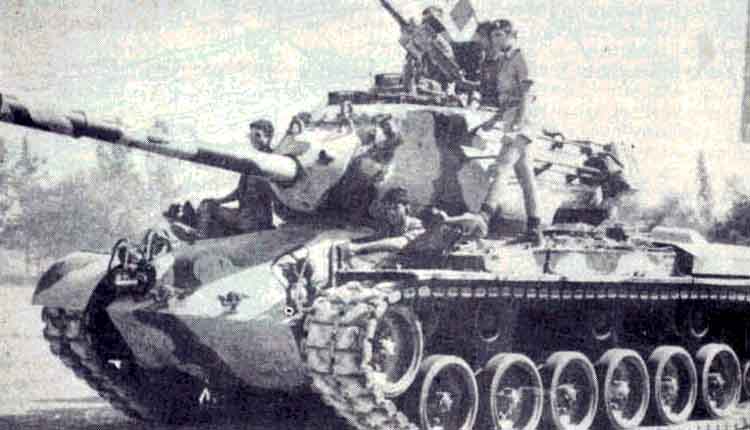
In 1974 after several periods of violence between the
ethnically split inhabitants of Cyprus, two NATO countries went to war with
each other. Today I’ll be looking at
some of the armour actions of that conflict on the small Mediterranean island.
In the early hours of July 20th 1974, a fleet of Turkish
ships appeared off of the coast of northern Cyprus. Originally they were
attempting to land and create a bridgehead at Glykiotissa, however, finding
this landing site unusable they switched to Pentemilli and began landing. In the first waves there were about 3000 men
and 20 M113’s. Two days later the first
Turkish armour landed, 15 M47 Pattons were brought ashore.
Facing them was the Greek Cypriot National Guard, most of
its heavy weapons were of Second World War British origin, such as 6 and 25
pounder guns, although it did have some more modern weapons.
The GCNG had an armoured branch on the island but these were
T-34/85 tanks brought from the Soviet Union and shipped via Egypt in 1964. They were a mash up of models and parts, but
had been fitted with US made M2 .50 calibre heavy machine guns. Old when they were delivered, after a decade
of use they were utterly worn out.
The first clash of armour came at 10:00 on the first day of
the invasion. A handful of T-34’s
supported by their infantry attacked the bridgehead, destroying two
M113’s. In return in a separate
engagement two T-34’s were destroyed by Turkish handheld anti-tank
rockets. Already the strain on the tanks
was beginning to show, several tanks had broken down and were abandoned. Another attempted counterattack that night
and two more T-34’s broke down, while a third got stuck in a dried up river
bed.
The next morning The Turkish Air Force destroyed the two
broken down tanks, while the one stuck in the riverbed was captured and freed
by the approaching Turkish forces. Three
days into the fighting and the Turkish force launched a breakout. The last local T-34’s had run out of ammunition
and were abandoned in place.
With a secure beachhead the Turkish forces were comfortable
with a ceasefire, to see if a diplomatic solution could be found. Meanwhile both forces prepared for another
clash. The Turks brought in more forces,
while the GCNG dug in.
While the diplomats talked, there were still several clashes
and outbreaks of fighting. The most
important to our story is the Battle of Kornos Hill (Hill 1024), located near
to Mount Pentadaktylos. In the morning
of the 2nd of August, the hill was attacked by a Turkish force. The defenders threw the attack back. In the afternoon a much larger force was
brought up and smashed the defenders aside.
The Turkish armour pushed on.
Leading the column was a pair of M47 tanks, followed closely by two
M113’s.
The armour wound its way along a narrow road cut into the
hillside. The road itself was only a few
inches wider than the M47 tanks with a sheer cliff face on one side, and a
wooded drop on the other. The lead tank
hit a mine, which blew its track off.
This was the cue for the defending GCNG infantry battalion
to open fire with its ambush. The
infantry was armed with M40A1 106mm recoilless rifles. Their first shot hit the 4th vehicle in the
column, one of the M113’s. The 106mm
HEAT warhead burned through the fragile light weight armour which was only
intended to stop shrapnel and caused it to go up in flames. The other M47 and M113 were trapped and
unable to move, with the M47 barely able to rotate its turret due to the
closeness of the cliff face. The Turkish
forces were forced to retreat.
The following morning a recovery team from the GCNG’s
Mechanized Battalion arrived at the site of the battle. They managed to free the two trapped
vehicles, and both were returned to their depot for repairs.
At the depot the M47 was found to have a broken hydraulic
turret traverse, in fact all the Turkish M47’s had had that system disabled.
The GCNG soon had the tank fully operational. In a stroke of luck the M47 was
not repainted.
Meanwhile the diplomatic efforts to find a peaceful
situation were going badly, and soon failed.
The Turks launched a new phase of offensives on August the
14th. Although they had lost some tanks,
the Turkish armour managed to drive 80 km’s in the first day, smashing aside
the defenders.
North West of Nicosia lies the village of Skylloura. The Turks attacked on the 15th with about 30
tanks reinforced with two battalions of paratroopers. The defenders consisted of five companies of
infantry, and one tank, the previously captured and now fully operational M47.
Early in the battle the infantry used a 106mm recoilless
rifle to knock out one of the attackers.
The Turks encircled the village and thats when the Greek M47
struck. In an audacious move she moved
through the confusion and joined the back of one of the Turkish tank
columns. The Turks just saw a friendly
tank joining their attack.
With total and utter surprise the M47 was able to attack the
Turkish tanks. For two hours she roamed
amongst the confusion of the battle using her superior gun traverse to out
manoeuvre the Turkish tanks. Often
disappearing then reappearing, the Turks didn’t know if it was a friendly tank
or not.
They found out the hard way as the 90mm gun suddenly and
with frightening speed swung in their direction before sending a shell roaring
towards them, followed closely by the loud clash of the shell striking armour.
After two hours the Greek M47 escaped from the battle back
to friendly lines. Behind her seven
Turkish tanks lay destroyed and burning.
That M47 remained in service with the Greek Cypriot National
Guard until 1993.